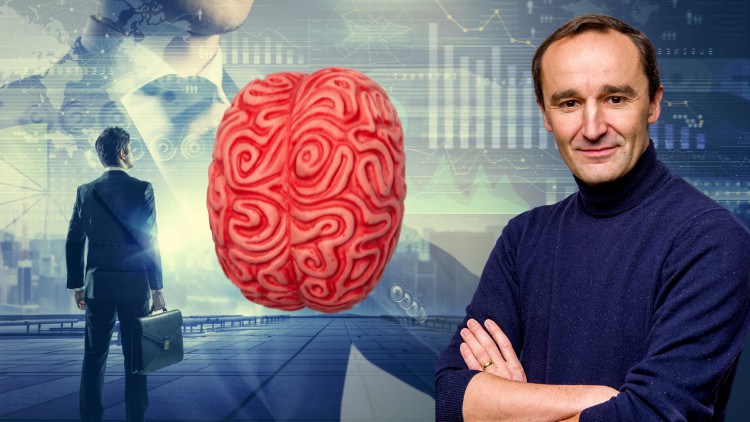The Science of Leadership
- Description
- Curriculum
- FAQ
- Reviews
- Grade

CPE Accredited course (Continuing Professional Education)
If you are a manager or entrepreneur in charge of a team, this course is for you.
This course has the ambition to build a bridge between a century of science and 21st century managers. A bridge between how our brain works and how to use that knowledge to improve our communication and leadership abilities.
To understand how and why Leadership works, we first need to understand what triggers us. We’ll be diving deep into our subconscious motivational processes. We’ll have a look at our brain, call it our ‘hardware’ and the subconscious programs running in it, that’s basically our software.
So expect tools, concrete and simple tools that you will be able to use right away with your team and colleagues. In the end, the aim of this course is to open the way for a new understanding of motivation and communication, towards a new, highly effective and sustainable model for leadership in this 21st century.
But most of all, by the end of this course, my aim is that you, as a manager, as a leader, will have understood what a crucial role you play in your team and in its success. And that you will be able to leverage that knowledge and guide your team to a new level of collaboration and engagement.
The Science behind the course…
I will provide a framework based on the latest insights in cognitive psychology and related fields. Within this framework I will present you studies, research and experiments on human behavior and I will show you how they apply to leadership and team management.
Behavioral sciences have gained an increased understanding of who we are as a species, what motivates us, what de-motivates us. Why we follow some people, and why we seemingly contradict ourselves so often.
The insights gained through social psychology, ethology, cognitive sciences and more recently the rapid breakthroughs in neurosciences thanks to MRI’s and advances in neuro-imagery, have given science a whole new understanding of who we are as human beings.
But then, when we look at the corporate world and management styles, there’s like this huge gap between both worlds.
Now this course, the Science of Leadership, aims to build a bridge between both. Giving managers the understanding of what drives their teams, and the tools to act upon it.
-
Discover a groundbreaking model – and manage yourself and others
-
Connect with your team – and discover what truly motivates them
-
Improve your coaching skills – through powerful communication tools
-
Fire up engagement in your team – by using two secret ingredients
-
Generate trust – and boost performance
-
Boost loyalty – and stop your people from going to your competitors
-
And So Much More… such as genetics, cognitive biases, subconscious belief systems, hiring protocols, sexism, bullying, change processes, brainstorming, meetings and so on …
CPE (Continuing Professional Education)
Learning Objectives
-
Recognize the 3 main subconscious influencers of human behaviour
-
Recognize how 4 brain structures influence our decision-making process
-
Differentiate between intrinsic and extrinsic motivations
-
Identify the most important brain chemicals involved in employee engagement
-
Identify cognitive biases negatively affecting team performance
-
Identify the most influential studies on how our social environment affects our behaviour
-
Understand the consequences of communicating in different mental modes
For additional information, including refunds and complaints, please see Udemy Terms of Use, which is linked from the footer of this page.
For more information regarding administrative policies, please contact our support using the Help and Support link at the bottom of this page.
-
3Reptilian Brain
Discover the home of our individual survival instincts
-
4Paleolimbic Brain
Discover how we position ourselves towards others
-
5Neolimbic Brain
Discover the home of our emotions, motivations and personalities
-
6Prefrontal Brain
Discover our very own supercomputer
-
7Brain based leadership styles
What would it look like, if we looked at leadership from a brain's structural perspective
-
8Dominance vs Leadership
Dominance and leadership, isn't that the same? No, not quite. Find it out in this lecture
-
9CPE Review Quiz: Section #2
Let's review what you've learned in Section #2
-
10Genetic Program
Introduction to how our genes influence our behavior
-
11Facing danger
So how do we react when we face danger?
-
12RSM - Relational Stress Management
How can we help our team members when they are facing stress?
-
13Avoid danger
-
14Avoid starvation
How does the instinct to avoid starvation impacts us today?
-
15Personalities
Explore a typology of 8 personality types
-
16Summary Genetic Programs
Summary of this section on Genetics as an influencer of human behavior
-
17CPE Review Quiz: Section #3
Let's review what you've learned in Section #3
-
18Prior Experience
Introduction to this section: how our prior experience influences our behavior
-
19The eye of the beholder (I)
Do we really see the world as it is? or rather as we are...? And how can we use that help our team evolve?
-
20Extrinsic Motivations
Extrinsic motivations? How do they work and where do they come from?
-
21Managing the Neolimbic brain
How does intrinsic and extrinsic motivations help us to be better managers
-
22Engagement - ingredient 1
Do you know the first secret ingredient to employee engagement?
-
23Engagement - ingredient 2
Do you know the second secret ingredient to employee engagement?
-
24Instant gratification
How does instant gratification impacts our team? and how can we deal with it?
-
25self evaluation
Do you know what you're worth? What you're capable of? Or are victim of this twisted cognitive bias?
-
26Workaholism
Why we have to manage a workaholic, and how
-
27Summary Prior Experience
Summary of how our prior experience influences our behavior
-
28CPE Review Quiz: Section #4
Let's review what you've learned in Section #4
-
29The importance of context
We are all much more influenced by the things and people around us than we would like to admit. Find out here why!
-
30Our team is not a sum of individuals
Find out how no one is an island. And even less so on the work floor.
-
311+1 = 1
Find out how more people does not always mean more ideas
-
32About authority
Find out why using authority ruins everything we work for as a leader
-
33The eyes of the beholder II
What if the way we look at others would influence their behavior...?
No, seriously, find out here everything there is to know about it.
-
34Summary of context
An overview of what we've seen in this section on how (social) context influences our behavior
-
35CPE Review Quiz: Section #5
Let's review what you've learned in Section #5







